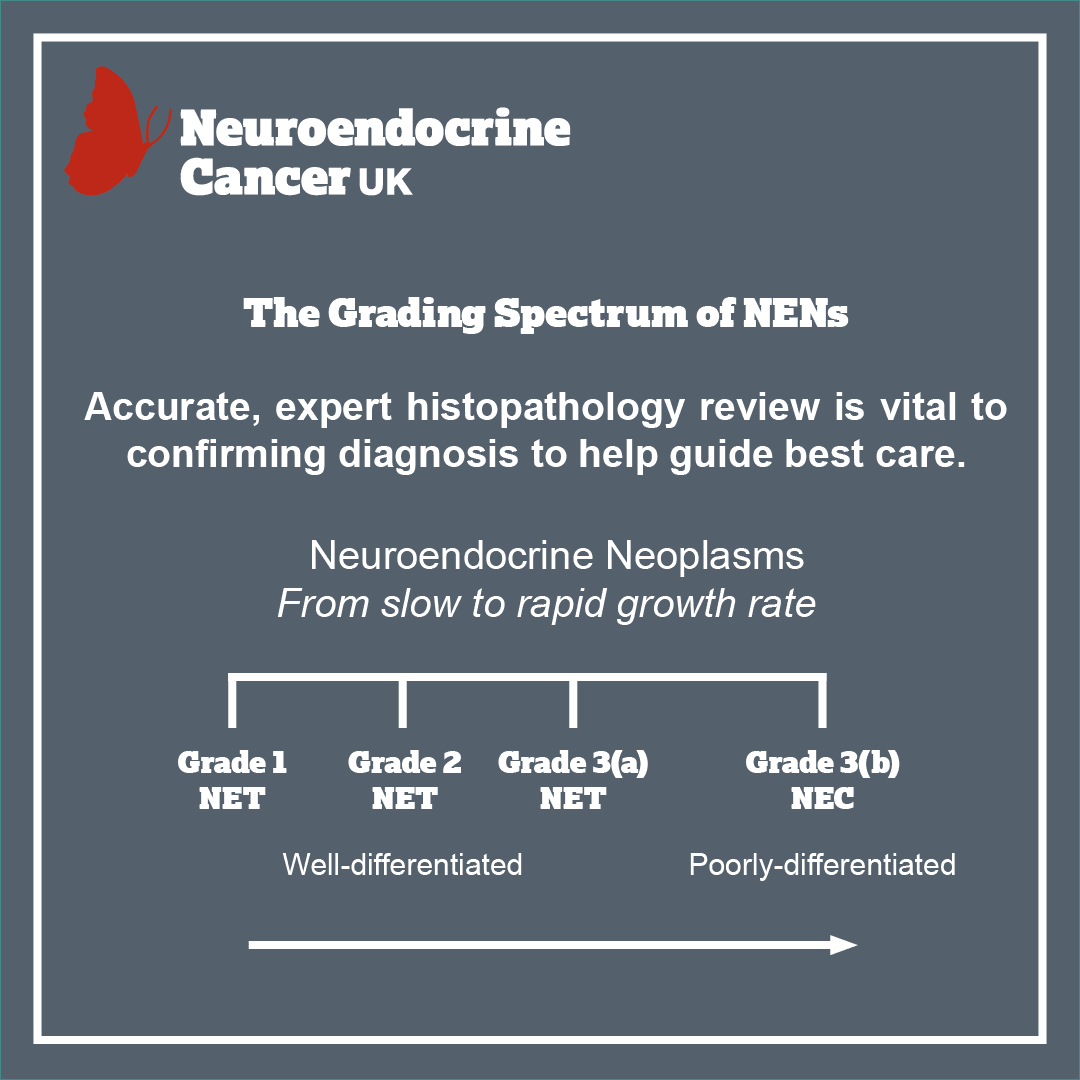NEUROENDOCRINE CANCER OF THE
RECTUM
The Facts
Neuroendocrine Neoplasm (NENs) is an umbrella term used to cover a group of cancers that start in neuroendocrine cells. These cancers may also be referred to as NETs, NECs, or even Carcinoids. NENs occur when neuroendocrine cells stop working normally and start to grow or behave abnormally.
There are 2 key types of NEN:
- NETs (neuroendocrine tumours) are called ‘well-differentiated’ and tend to have a slow to moderate growth pattern.
- NECs (neuroendocrine carcinomas) – are called ‘poorly differentiated’ and tend to grow rapidly.
To simplify, we use the term NENs throughout this page.
Rectal NENs
The rectum is the final segment of the large intestine that connects the colon to the anus. It stores waste produced in the colon until the body is ready to eliminate the waste through the process of defecation (having a poo!). It is a hollow muscular tube 6 – 8 inches (15 – 20 centimetres) in length and 2.5 inches in diameter at its widest point.
Although Rectal NENs are one of the most commonly diagnosed NENs (in part related to colon cancer screening investigations) they are amongst the least common colorectal cancers (<2%).
In the early stage the rectal NEN may present as a small polyp (less than 1 – 2 centimetres), or a flat doughnut shaped lesion. Larger polyps or lesions are possible, both with and without disease spread. In either case there are clear treatment and follow up protocols in place that will be discussed with you.
Symptoms
Symptoms that may or may not include Neuroendocrine Cancer associated syndromes. (Syndrome is where 2 or more related symptoms occur).
Symptoms of Neuroendocrine Cancer of the Rectum may include:
- Bleeding from the bottom (rectal bleeding)
- Itching and pain around the rectum and or anus
- Small lumps around the anus
- A discharge of mucus
- Loss of bowel control (bowel incontinence)
- Constipation
- A feeling that your rectum doesn’t empty completely or Tenesmus – a continual or recurrent feeling that you need to defecate / open your bowels
- Weakness or fatigue
- Unexplained weight loss
However, many people experience no symptoms at all in the early stages of the disease. When symptoms appear, they may be related to the cancer’s size and location.
Neuroendocrine Cancer of the Rectum is rarely associated with a Neuroendocrine associated syndrome.
Other, rarer symptoms, including Paraneoplastic syndrome and oncological emergencies, (a specific set of health concerns that can occur in any cancer), such as raised calcium levels (Hypercalcaemia), may occur.
Further information about Neuroendocrine Cancer associated and Paraneoplastic Syndromes – including Oncological emergencies – can be found here.
Tests
Tests that may be used for the diagnosis and / or monitoring of Neuroendocrine Cancer of the Rectum:
Blood and / or urine:
Full blood count
(B12 + serum Iron)
Liver and kidney function
Biochemical :
Chromogranin A (and B)
Urinary 5-HIAA
CEA
β-HCG
Pancreatic polypeptide.
Scans and further investigations:
Endo-anal Ultrasound
Sigmoidoscopy / Colonoscopy +/- biopsy.
Pelvic MRI
Contrast CT : chest/abdomen/pelvis
Gallium-Dotatate PET/CT (SRS SPECT/CT if Dotatate PET n/a)
FDG-PET – if High Grade / rapidly progressing disease.
Pathology (what can be seen through special tests under a microscope):
Differentiation and cellular morphology
Synaptophysin
Chromogranin
Ki67
Low molecular weight keratins
GLP
PP/PYY
CD56
Prostatic acid phosphates.
Select play to watch this short video where Professor Martyn Caplin discusses Rectal Neuroendocrine Neoplasms.
Grading
Not all cancers are the same or behave in the same way. Some may grow very slowly, may not have invaded nearby structures, or spread to other parts of the body at the time of diagnosis – but they have the potential to. However some may have already spread at the time of diagnosis. The grade is the rate at which the NEN grows. You might see this referred to as ‘Ki67’ or ‘Mitotic Index’ mentioned in your clinic letters or medical reports. Grade 1 is slow-growing through to Grade 3, a more aggressive, rapidly growing disease.


Causes and / or risk factors
We do not know exactly what causes NENs, however research is ongoing to truly understand both the pathology and the biology with the hope that this will lead to a much better understanding of the causes.
Most NENs do not run in families; however, there are a number of rare conditions that may increase your risk. Therefore, if other members of the family have been diagnosed with a particular cancer (especially aged 50 years or less) or cancer-associated genetic condition, it is important that you tell your specialist team about not only your medical history, but also any family medical illnesses or conditions.
So how is it treated?
For all patients, there are many things to consider in planning treatments. Your treatment will be personalised to you and the type of NEN you have. Even if you have a diagnosis that sounds the same as another patient, your treatment and follow up plan may be different.
Rectal NENs, are usually, but not exclusively, small and grade 1 or grade 2. Many may be completely removed, as a polyp, by an endoscopic resection. The size and stage of the NEN is really important in deciding the correct treatment pathway.
Your care team will discuss your treatment options with you – giving you both written and verbal information – to help you make an informed choice. Together you can agree on the most appropriate treatment for you. There is consensus agreement that all NEN patients should be reviewed by a specialist MDT.
Treatment options will depend on the type, position and size of your NEN, and whether (or to where) it has spread. It will also depend on whether you have any other health concerns and / or illnesses and your general health and fitness. A big part of meeting with your doctors or specialist nurse/team, is to make sure you get the information you need to understand your condition.

The key aim of treatment, should be to help you have the best possible care and quality of life – by ensuring access to appropriate treatment, management of symptoms and addressing what’s most important to you
Treatment options will depend on the type, position and size of your cancer – and whether (and to where) it has spread.
It will also depend on whether you have any other health concerns and / or illnesses and your general health and fitness.
One or more of the approaches below may be suggested:
- Surgery
- Control of your disease, by slowing or stopping further growth and / or spread
- Palliation, or easing, of any symptoms you may be experiencing.
Surveillance:
Monitoring through clinic review, bloods and scans, can be used to assess how well treatment is working or in periods between treatments (which may be months/years).
As not everyone will need to be on treatment – surveillance can be used to check your cancer and general health for any signs of change that may mean that a treatment might need to be considered. All treatments have possible side-effects, therefore, it is important to know when treatment may be helpful for you or not.
Surgery:
Will depend on site, size, position and spread of your Neuroendocrine Cancer. Some rectal cancers develop within polyps – others form solid tumours.
A polyp is a small cell clump that develops in 2 ways : Pedunculated polyps hang from a short stalk. Sessile polyps are flat and they grow directly out of the surrounding tissue.
If your neuroendocrine cancer develops within a polyp you may be able to have it removed by:
Polypectomy:
Polyps are removed during endoscopy using hot or cold forceps or a snare.
EndoMucosal Resection (EMR):
An endoscope is introduced to the site of the polyp. Using a small needle a fluid is injected underneath to raise the polyp creating a safe field to remove it using a snare. The area is then cauterised (to stop bleeding).
Endocopic Submucosal Dissection (ESD):
The procedure is similar to EMR but uses a small knife, rather than a snare, to remove the polyp, cauterising blood vessels at the same time to prevent bleeding.
If it is a large polyp or small tumour you may be able to have it removed by:
Transanal Mucosal Surgery (TEMS):
Using a specially designed microscope and instruments, this procedure allows surgery to be performed through the anus (back passage) inside the rectum.
TransAnal Minimally Invasive Surgery (TAMIS):
A specialised laparoscopic surgery port is placed into the anus. The laparoscope and instruments required to carry out the procedure are passed through the port to the rectum, so that the polyp or tumour can be surgically removed.
Larger or more invasive disease will require more complex surgery:
Total Mesorectal Excision (TME):
Is surgery to remove the rectum and sigmoid colon, including the blood supply and associated lymph glands. This procedure may result in a temporary or permanent colostomy dependent on whether is possible to rejoin the end of the healthy bowel to the anus.
Anterior-Perineal Extirpation:
Is surgery to remove the lower part of your (descending) colon, sigmoid, rectum and anus – along with associated lymph glands. This procedure results in a permanent colostomy.
*A colostomy is formed by bringing part of your colon (large bowel) or the end or loop of ileum (small bowel) out on to the surface of your abdomen to form a stoma (an opening) – and may be temporary or permanent – depending on how much bowel is removed, how much you have left and how healthy your remaining bowel is. Waste passes out of the stoma and is collected in an external pouch (known as a stoma bag). if your colostomy is temporary, further surgery make take place at a later date, to rejoin your bowel and close the stoma – this is called a stoma reversal.
Non-surgical treatments:
- Somatostatin analogues (SSAs)
- Chemotherapy
- Targeted Molecular Therapies
- Peptide receptor radionuclide therapy (PRRT)
- Radiotherapy
- Interventional radiology
- Clinical Trials
- Symptom Control

Follow up
There are expert agreed guidelines regarding how and when follow up should occur, however, in practice this varies and often with good reason. Follow up should be expert informed & evidence /research based but also tailored to you and what is appropriate for your best care.
Following surgery/endoscopic resection – for minimum 10 years:
- G1/2 <1cm: no lymph nodes, no evidence of invasion: there is no data re recommended follow up.
- G3 <1cm: annual follow up with colonoscopy.
- G1/2 1-2cm: annual follow up with colonoscopy.
- Biochemistry alongside colonoscopy/scan.
ALL Neuroendocrine Cancers >2cm require ongoing follow up – minimum 10 years (nb metastatic disease has been seen beyond this time):
- G1/2: annual colonoscopy + CT + biochemistry.
- G3: 4 – 6 monthly colonoscopy + CT + biochemistry for the first year, then annually.
If liver tumours present – for MRI or contrast CT concurrent with follow up timings.
Advanced disease:
- Follow up as per guidelines – but should be guided by prognosis, expected treatment efficacy and treatment related toxicity. Your health, well-being, physical activity, informed choice and preference for ongoing care as well as aim of treatment should be reviewed and discussed to best plan care.

